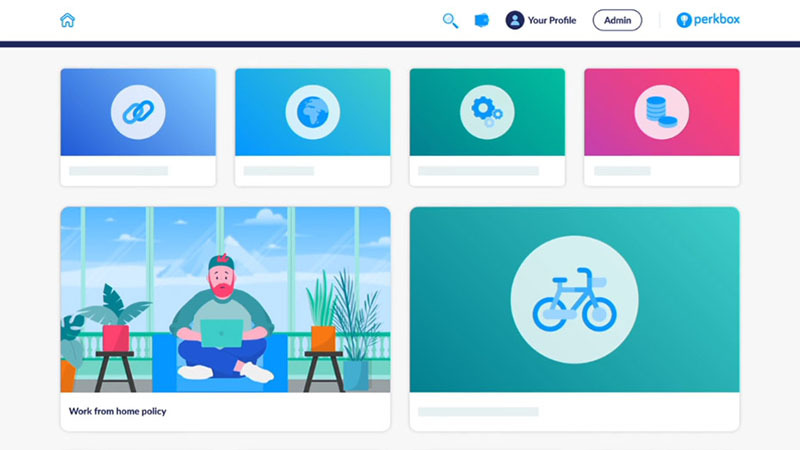14 positive company culture examples and why they work so well
All of these companies have a great company culture, so we recommend taking note of what they do.
1. Perkbox
Perkbox are a company of culture enthusiasts who developed a global rewards and benefits platform. Their mission is to help as many organisations as they can to deliver the best employee experience possible. Their values are people-centric and they pride themselves on a collaborative and open culture, which their intuitive platform supports.
What they do well:
- Use technology to facilitate communication
- Have an engaging reward and recognition scheme
- Encourage a healthy work-life balance
![A casual meeting where employees all sit on comfortable beige couches.]()
2. Starling Bank
Starling Bank is no ordinary bank. Their teams provide a fully online service with the aim of making banking a fairer environment, in comparison with traditional bricks and mortar institutions. Because Starling Bank are futurists, they understand the importance of social wellbeing and its impact on the overall corporate culture. Consequently, their offices are open plan and they make time for team-building activities, which keeps morale high.
What they do well:
- Encourage social interaction
- Design the physical work environment to be as social as possible
- Recognise and promote star performers
3. Wagamama
Wagamama follow the ‘Kaizen’ or good change philosophy in their approach to cooking and running their business. While working in a restaurant is often fast-paced, employees say they feel supported by their managers and that Wagamama is a great company for people who are new to the hospitality industry.
What they do well:
- Offer flexible hours
- Appreciate their teams
- Provide perks and freebies
4. Jack Wills
Jack Wills is a preppy lifestyle and fashion brand. Managers focus on making their culture as inclusive as possible, which their young teams appreciate. A particular challenge that Jack Wills and many other similar companies face is demonstrating that retail is a serious long-term career option with numerous benefits. So, for this reason, their employees also get access to a comprehensive perks and discounts package.
What they do well:
- Frequently recognise their employees’ achievements
- Create an inclusive environment
- Support their teams’ career aspiration
![Fashion brand employees inspecting a blue denim jacket and smiling together.]()
5. Wasabi
Wasabi is a high-street food vendor that specialises in East-Asian food, such as sushi and bento. Opening in 2003, Wasabi grew to open many branches around the UK and internationally. Unlike some companies, Wasabi never lost its unique tight-knit culture as it expanded. In fact, employees today say they feel a sense of belonging, which is sometimes difficult to find in the hospitality industry.
What they do well:
- Nurture a culture that feels more like a family than a place of work
- Encourage their colleagues to get to know each other
- Excellent training
6. Purple Bricks
Purple Bricks is an innovative and modern estate agent that’s shaking up the real estate industry. Because of their ambitious rapid growth plans, they want to make their culture as attractive as possible. So it’s no surprise Purple Bricks employees are some of the happiest you’ll meet, with many crediting their manager’s support in making them feel part of a team, regardless of if they’re in the office or working remotely.
What they do well:
- Office and remote colleagues feel part of one team
- Offer a competitive perks and discounts package
- Recognise and reward teams who go the extra mile
7. The Gym Group
The Gym Group’s mission is to make fitness affordable, so that everyone in the UK has access to high-quality training and gym equipment. Because they’re in the health and fitness industry they’re particularly good at taking care of their teams’ wellbeing. Not to mention they’ve successfully cultivated a friendly and welcoming culture that benefits gym-goers and employees alike.
What they do well:
- Offer flexible working hours
- Give staff autonomy to choose their own break times
- Run frequent team building games
![A flexible employee working until later evening hours.]()
8. CV-Library
CV-Library want to make the recruitment process as efficient and easy as possible. They’re the UK’s favourite job board and put just as much effort into looking after their teams as they do connecting job candidates with employers. Employees report good professional growth opportunities and often receive recognition for their work. Many also say they have a healthy work-life balance.
What they do well:
- Hire people that share similar values
- Promote a healthy work-life balance
- Organise regular social events
9. Royal Berkshire NHS
The NHS needs no introduction. It’s a British institution that has been taking care of the country’s health since 1948. Because the Royal Berkshire Foundation is one the largest foundations in the UK it’s important the trust retains staff in order to meet patient demand. Employees say the Royal Berkshire Trust is a great place to work and that there are plenty of opportunities to develop and grow.
What they do well:
- Provide high levels of support
- Offer opportunities for professional development
- Have a perks and discounts scheme
![A healthcare staff member reading her perks and discounts scheme on her phone.]()
10. White and Company
White and Company is an accountancy and business management firm that offers financial advice to small to medium-sized enterprises (SMEs) and high net-worth individuals. Due to its size, White and Company can offer a more boutique service than other larger organisations. White and Company employees feel they’re part of one big family and say that no two days are the same.
What they do well:
- Give their employees plenty of autonomy
- Invest in team development opportunities
- Recognise and promote top performers
![A top-performing employee laughing at his laptop while wearing a headset in a meeting.]()
11. Flight Centre
Flight Centre is one of the world’s largest travel groups, selling holiday packages, cruises, flight tickets, and more. Like other similar companies, they understand the importance of employee wellbeing, so their teams are entitled to several health benefits in addition to a competitive discounts package. Employees regularly talk about how fun training days are and that Flight Centre have their best interests at heart.
What they do well:
- Invest in wellbeing
- Motivate teams with meaningful perks
- Make training days fun
12. Menzies
Menzies is one of the leading accountancy companies in the UK. They’re naturally innovative and look for similar qualities in the talent they recruit. To stand out from the competition they take a proactive approach to employee experience and have launched a ‘Brighter Thinking’ initiative to improve recognition and wellbeing. Employees say they appreciate the time and effort Menzies put in to improving the employee experience.
What they do well:
- Take proactive steps to enhance culture
- Recognise and reward talent
- Recruit like-minded people
13. BookingGo
Over recent years, BookingGo has experienced transformation, growth, and even a name change. However, they also want to retain some of their history, in particular their values and company culture. Employees have always spoken highly of BookingGo’s supportive culture and training opportunities. So to keep their teams happy in times of change, BookingGo invested in a new benefits and discounts scheme.
What they do well:
- Act on employee concerns
- Invest in wellbeing and benefits
- Treat their employees fairly
![A woman]()
14. Hendy Group
Hendy Group is a family-run motor dealership with a rich history. In fact, it was one of the first dealerships to strike a deal with Ford in 1910. While Hendy is a very old company, their employee experience is modern. Unlike some other traditional companies, senior leaders at Hendy Group take the time to understand what their employees value. Hendy employees say they receive recognition for their work and enjoy a range of perks and company benefits.
What they do well:
- Appreciate their employees
- Follow their values
- Offer learning opportunities















Share